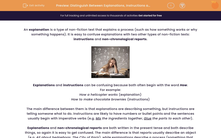An explanation is a type of non-fiction text that explains a process (such as how something works or why something happens).
It is easy to confuse explanations with two other types of non-fiction texts: instructions and non-chronological reports.

Explanations and instructions can be confusing because both often begin with the word How.
For example:
How a helicopter works (explanation)
How to make chocolate brownies (instructions)
The main difference between them is that explanations are describing something, but instructions are telling someone what to do. Instructions are likely to have numbers or bullet points and the sentences usually begin with imperative verbs (e.g. Mix the ingredients together, Glue the parts to each other).
Explanations and non-chronological reports are both written in the present tense and both describe things, so again it is easy to get confused.
The main difference is that reports usually describe an object (e.g. All about hedgehogs, The City of Paris), while explanations describe a process (something that happens).
Explanations are written in time order and use connectives such as first, then, after that and finally.
In this activity, you can practise telling the difference between explanations, instructions and non-chronological reports. Remember that you can look back at this introduction as often as you like by clicking the red Help button on the screen.









